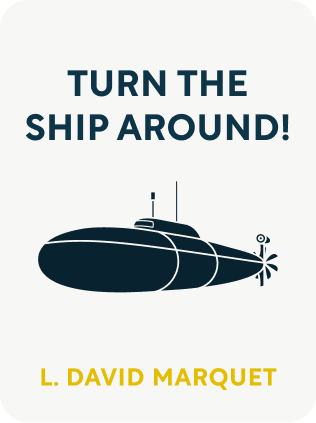

This article is an excerpt from the Shortform book guide to "Turn the Ship Around" by L. David Marquet. Shortform has the world's best summaries and analyses of books you should be reading.
Like this article? Sign up for a free trial here .
What if every member of your team fully grasped your organization’s mission? How can you achieve this clarity of purpose?
Submarine commander David Marquet understood the power that clarity of purpose wields. This is especially true in a leader-leader model, when each team member is empowered to make decisions. To achieve clarity with his crew, he employed several mechanisms to ensure clarity of purpose so that the decisions they made aligned with what the whole team was trying to accomplish.
Read more to learn how to achieve clarity of purpose.
The Leader-Leader Model Requires Clarity of Purpose
Along with competence, a leader-leader model that decentralizes control also requires clarity of purpose. Everyone needs to understand the organization’s goals so that the decisions they make align with what the organization is trying to accomplish. If the purpose isn’t clear, the criteria on which decisions are made may be off base, leading to bad decisions.
Here are five of the mechanisms Santa Fe adopted to ensure clarity of purpose:
- Be inspired by your organization’s legacy. Create a sense of mission by connecting present efforts with the past accomplishments.
- Create guiding principles to aid decision-making.
- Immediately recognize excellent performance.
- Begin with the end in mind: Set long-term goals.
- Encourage questions, not blind obedience.
Mechanism #1: Be Inspired by Your Legacy
As Santa Fe headed through the China Sea toward the Strait of Malacca and the Arabian Sea, the officer of the deck announced on the mic that they were passing the location where the USS Grayling was sunk in September 1943.
The announcement was a reminder to Marquet that the U.S. Navy submarine force had a great legacy of service to the country. However, there wasn’t any formal program for sharing it to inspire and motivate those currently serving.
In addition to calling attention to the sites of sunken submarines, Santa Fe staff found several ways to connect the present with the past—for example, they incorporated historical notes in the Plan of the Day. While at Pearl Harbor, officers visited the USS Bowfin submarine museum as “training.”
Highlighting their legacy created organizational clarity by reminding sailors of Santa Fe’s larger purpose. Being inspired by your legacy is a mechanism for clarity of purpose.
Mechanism #2: Create Guiding Principles
Being on deployment gave Santa Fe’s officers the opportunity to finalize a set of guiding principles. They wanted the principles to help crew members use the right criteria when making decisions. The theme they came up with was “Leadership at every level,” and the principles included:
- Initiative: Take action without direction from above to increase your knowledge, improve submarine operations, and solve problems.
- Innovation: Look for new ways to do things. Have the courage to change and to fail.
- Technical knowledge: Take responsibility for learning your job. Know the details of your watch stations and how systems work.
- Courage: Choose to do the right thing, even if it’s uncomfortable. Admit mistakes.
- Commitment: Be mentally engaged when you’re working, and give it your best.
- Empowerment: Encourage those below you to make decisions and support them if they make mistakes. Specify goals but not methods.
- Openness: Speak your mind with others and also be open to new thinking.
To reinforce the principles, officers used the language of the principles in award citations and evaluations.
Guiding principles are a mechanism for clarity of purpose. It’s important that your guiding principles represent the real, not idealized principles of the organization. Since the principles are to be used for decision-making, they need to be aligned with the organization’s real goals.
Questions for Leaders
- What are your organization’s guiding principles?
- How do you communicate them? Are they cited in evaluations and awards?
- Are they useful to employees as decision-making criteria? Are they used as such?
Mechanism #3: Immediately Recognize Top Performance
Santa Fe moved on the surface through the crowded Strait of Malacca, between Singapore and Indonesia, because it was shallow. Numerous large vessels, as well as ferries and fishing boats, used it daily, which made the three-day passage tricky.
The submarine’s crew decided it would be safest to follow closely behind an empty tanker, which other vessels would avoid. Marquet was driving the submarine from the bridge at night, when he suddenly saw a dimly lit tugboat that was pulling a barge cross in front of them. Santa Fe had to reverse its engines and managed to stop just before hitting the tow line.
Marquet immediately went below and commended the engineering team for avoiding an accident. The man who saved the ship was the petty officer who had previously violated a red tag. Later, at the crew’s mess, Marquet praised the petty officer for his professionalism and pinned a Navy achievement medal on him. He would later file a report, but used immediate recognition to reward and reinforce outstanding performance.
Typically, the Navy is slow to provide recognition and awards, letting administrative processes get in the way. Yet immediate recognition is a powerful motivator and reinforcer of desired behaviors. Immediately recognizing top performance is a mechanism for clarity of purpose.
Mechanism #4: Begin with the End in Mind
Marquet decided to have a one-hour mentoring session with a key supervisor each day focused on long-term issues and goals. He asked supervisors to identify the end-of-tour awards they were striving for, or write their own personnel evaluation for the next year, indicating what they would accomplish.
To keep the mentoring from falling into a leader-follower format, Marquet developed it as a mentor-mentor program, where both he and the officer shared ideas on what Santa Fe needed to accomplish and what the officer could do for himself and to support the ship.
Together, they wrote specific, measurable goals for each supervisor and a plan to accomplish them, and determined how to measure achievement. In one case, the officer’s end-of-tour citation two years later sounded exactly like what they’d written. By beginning with the end in mind, they achieved the desired results.
Beginning with the end in mind is a mechanism for clarity of purpose.
Beginning with the end in mind—envisioning the results you want and developing a plan for achieving them—is important for every organization. Plans should have specific, measurable goals.
Here are some ways you can apply this concept in your organization:
- With your senior leadership, read and discuss chapter 2 of Stephen Covey’s The 7 Habits of Highly Effective People. (Shortform note: Read our summary of The 7 Habits of Highly Effective People.)
- Develop three- to five-year goals for your organization.
- In evaluations, use statements that quantify achievements, using measurements previously agreed on.
- Have employees write their own evaluations for several years out—their goals should align with organizational goals and be quantifiable.
Mechanism #5: Encourage Questions, Not Blind Obedience
In the Arabian Gulf exercise, Santa Fe was assigned to attack another sub, the USS Olympia, which was playing the role of an enemy diesel boat. They were halfway through the deployment, and were preparing to fire the first submarine-launched torpedo in the Arabian Gulf.
A rear admiral was on board observing the exercise, which would demonstrate not only Santa Fe’s abilities, but also the ability of a U.S. submarine to attack and sink a submarine in shallow water. The exercise was designed to send a message of deterrence to potential U.S. adversaries. It also was a test of the leader-leader model.
Santa Fe’s crew performed flawlessly without Marquet’s involvement. The exercise torpedo scored a hit, which Marquet announced to the cheers of the crew.
Two months later, Santa Fe had returned from deployment and was conducting an exercise with the Navy SEALs. The submarine was to pick up a SEAL team dropped by a helicopter, secretly drop the team near shore, then recover them after their mission. The team left the submarine and would return to it in inflatable rafts.
While maneuvering to pick up the team, Santa Fe got into water that was too shallow. Further, Marquet looked at the controls and thought the ship was going the wrong direction to reach deeper water. He ordered the quartermaster, Sled Dog, to back up and was stunned when Sled Dog responded, “No, you’re wrong.”
Then Marquet remembered that the plan was for the submarine to be turned so it faced away from the shore while awaiting the Seal team, in order to make a quick getaway. Santa Fe moved forward 100 yards into deeper water, and moments later, they spotted the Seals on their rafts. Had the crew followed Marquet’s order, they could have missed the pickup.
Encouraging questions, not unthinking obedience is a mechanism for clarity of purpose. A culture that encourages questioning builds organizational resilience, or ability to resist errors. The crew had clarity on the mission and therefore the confidence to question the commander—and a mistake was averted.
Questions for Leaders
- Does your organization have a culture that encourages questioning over blind obedience?
- How can you create a resilient organization where errors are stopped?
- Would your managers or employees unquestioningly follow a wrong order?

———End of Preview———
Like what you just read? Read the rest of the world's best book summary and analysis of L. David Marquet's "Turn the Ship Around" at Shortform .
Here's what you'll find in our full Turn the Ship Around summary :
- How a captain turned the U.S. Navy’s worst-performing nuclear submarine crew into one of the best
- The principles for developing leaders at all levels to create a passionate, high-performing workforce
- Why the "leader-leader" model works better than the "leader-follower" model






